Media
Transcript
Astronomy can be described in many ways: awe-inspiring, mind-blowing, complicated. There are so many adjectives to pick from that sometimes calling it astronomical is the safest bet. Today though, our science comes with one clear descriptor: pretty.
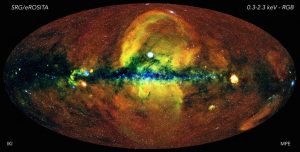
The team behind the eROSITA X-ray instrument aboard the Russian-German Spectrum-Roentgen-Gamma (Spektr-RG) telescope has released its first all-sky survey. This amazing dataset looks at the X-ray sky in higher resolution and with greater sensitivity than has ever been observed, going four times deeper than the ROSAT mission’s all-sky map. This is the first data release from this mission and represents only the beginning of what it will produce. During the next 3.5 years, the spacecraft is scheduled to complete seven survey mappings of the sky that, when combined, will give us five times the sensitivity of this first survey.
The X-ray sky looks very different from what we’re used to with our optical telescopes and eyes. By combining data from more than 400 million photons with X-ray energies between 0.2 and 8 keV, this team has built amazing color images of our high-energy sky that allows us to clearly see these differences. The center of our galaxy appears not as a blob of stars but instead as the center of an hourglass. The two bulbs of the hourglass are Fermi bubbles – bubbles of material that were pushed out and shocked by the energetic feeding of our galaxy’s supermassive black hole at some point in the past. Scattered through the sky are notes of bright light with supernovae remnants and the nearest star-forming regions and galaxy clusters.
Publications of surveys like this enable future research that can statistically analyze how common different kinds of objects may be and understand the systematics of our universe. In general, surveys don’t feature a lot of results. I can tell you the survey is estimated to contain 1.1 million sources that are mostly active galaxies, as well as some stars with strong, magnetically active hot coronas. While of enormous scientific interest, galaxy clusters are just 2% of the sources, and the fraction of sources that are associated with X-ray binaries, supernovae remnants, and star-forming regions is even smaller.
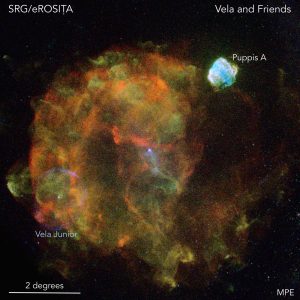
To highlight the quality of their instrument, the team showcased several key features in their data. One of the most stunning is their imagery of the triple nebula Vela, Vela Junior, and Puppis. These three supernovae remnants vary in age and distance, with both Vela and Puppis A containing pulsars. Taken together, they give us a singular perspective on this kind of object.
While less spectacular, my favorite feature in their data is the light echo of a transient X-ray source. At some point in the past, the X-ray binary MAXI J1348-630 went into an outburst and erupted with X-ray light. While some of that light traveled straight toward us, most of it went off in every other possible direction. Some of that other light, however, has scattered off surrounding material and made its way toward us thanks to that bounce. We see that scattered light as a spectacular little ring around the binary.
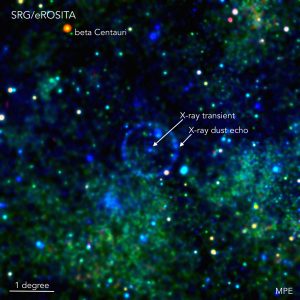
While the Chandra X-ray Observatory has produced a lot of stunning X-ray images over the years, this is the first time we’ve had an X-ray survey capable of this kind of stunning data collection.
Most telescopes aren’t survey telescopes, but every facility was built with a certain purpose in mind. One of the oft-forgotten purposes of the Hubble Space Telescope (HST) was to understand the planetary nebulae. Now, more than thirty years after its launch, HST is still struggling to fulfill this goal.
When stars approach the ends of their lives, they shed their outer layers. This material drifts away, creating a myriad of complex shapes that appear as a round or roundish blob in most Earth-based telescopes. With Hubble, these blobs get resolved into complex shockwaves and tendrils of material, and even back in 1997, it was apparent that these nebulae don’t have a one-size-fits-all explanation of their structures.
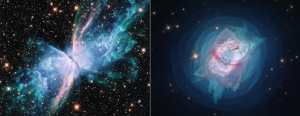
Today, using the third edition of the Wide Field Camera, astronomers have shown that the level of details and nuance seen in these objects only goes up as the observations get better. Using the full observational range of Hubble, from the ultraviolet all the way out to the infrared, researchers have looked at two previously studied nebulae, NGC 6304 or the Butterfly Nebula, and NGC 7027 which is the Jewel Bug Nebula. The two bizarrely shaped nebulae are thought to be the result of binary systems where the orbital plane of the two systems pinched in the waist of the expanding material to create an hourglass. The different colors in these images each trace different atoms and temperature ranges. The images’ high resolutions allow individual shockwaves to be studied, revealing in the process that both systems underwent rapid fluctuations.
In fact, the researchers can even measure some differences between these latest images, and those captured by Hubble early in its lifetime.
Ultimately, researchers hope to sort the details behind how these structures form. It’s nice to say these are binary systems, but that lacks specifics. There are currently two competing theories for their formation: either two stars orbit one another and interact such that they create a disk, which in turn generates the outflowing material, or the two stars merge, and the merged object has outflowing jets. According to team member Bruce Balick: The hypothesis of merging stars seems the best and simplest explanation for the features seen in the most active and symmetric planetary nebulas. It’s a powerful unifying concept, so far without rival. While astronomers continue to study this problem, we can continue to expect more amazing imagery. I have to admit it almost makes me hope that it takes them a long time and a lot more nebulae to find all the answers they want.
Our final story of the day has no pretty pictures, but it does come with a pretty illustration.
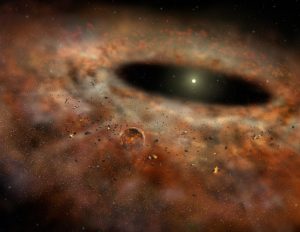
Folks studying planetary formation have been struggling with just about everything. Back before we had good data, some models suggested that planets might form in a few hundred thousand years once the process got started, and then we started seeing disks around stars that are one to three million years old, and things looked good for forming planets until we realized those disks don’t have enough stuff to form planets. So what’s going on?
It turns out that that the disks we’ve been looking at are likely post-planet formation and are, in many cases, only showing us what is left behind. In a new paper in Astronomy & Astrophysics, a team of Dutch observers describes new observations of protostars (still forming) in the Perseus Molecular Cloud, and they found that the conditions in these exceedingly young systems are perfect for planet formation. This means that before a star fully settles into nuclear burning, it already may have planets surrounding it. So yes, planets can form in a few hundred thousand years, and it is in the first few hundred thousand years that formation takes place.
For now, though, this is all the science we have for today.
Learn More
Our deepest view of the X-ray sky
Stunning New Hubble Images Reveal Stars Gone Haywire
- Hubblesite news release
- Hubble Space Telescope press release (ESA)
- “First Results from a Panchromatic HST/WFC3 Imaging Study of the Young, Rapidly Evolving Planetary Nebulae NGC 7027 and NGC 6302,” Joel H. Kastner et al., 2020 June 15, Galaxies
Planets must be formed early
- NOVA Astronomie.nl press release
- “Dust Masses of Young Disks: Constraining the Initial Solid Reservoir for Planet Formation,” Lukasz Tychoniec et al., 2020, to appear in Astronomy & Astrophysics (Preprint on arxiv.org)
Credits
Written by Pamela Gay
Hosted by Pamela Gay
Audio and Video Editing by Ally Pelphrey
Content Editing by Beth Johnson
Intro and Outro music by Kevin MacLeod, https://incompetech.com/music/


 We record most shows live, on Twitch. Follow us today to get alerts when we go live.
We record most shows live, on Twitch. Follow us today to get alerts when we go live.